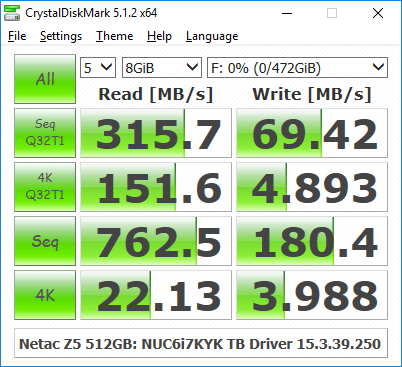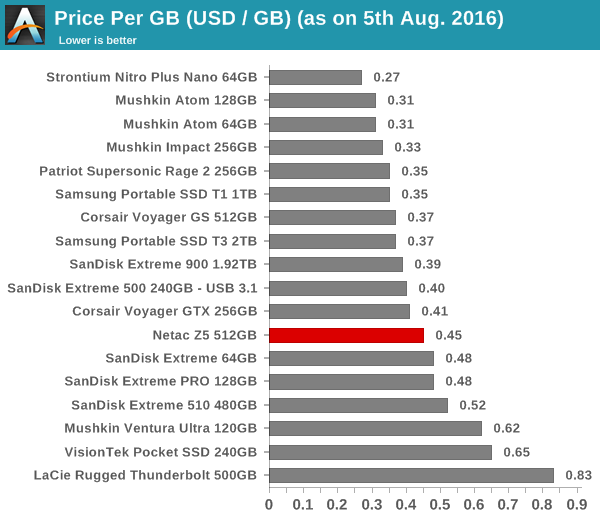Netac Z5 USB 3.1 Gen 2 Portable SSD Review
by Ganesh T S on August 9, 2016 8:00 AM ESTMiscellaneous Aspects
One of the major pain points associated with USB 3.1 Gen 2 SSDs (such as the SanDisk Extreme 900 and the Netac Z5 being evaluated today) is performance consistency across different host systems. There are two popular USB 3.1 Gen 2 bridge chips used by systems and boards currently in the market - the ASMedia ASM1142 and the Intel Alpine Ridge. The driver scenarios for both are quite tricky, depending on the vendor of the board / card / system. ASMedia's custom drivers for ASM1142 are no longer needed, given that Windows 10 bundles a Microsoft USB 3.1 xHCI driver. In the case of Alpine Ridge, even though the Microsoft xHCI drivers are utilized, the Thunderbolt driver version also plays a major role in the performance.
We evaluated the performance of the Netac Z5 across a host of different systems using multiple driver versions.

As one can see from the CrystalDiskMark numbers, the performance is heavily dependent on the drivers being used. In multiple cases, we found that writes wouldn't go above 100 MBps. To confound matters further, the ASMedia ASM1142-equipped systems sometimes performed worse with newer driver versions. It is always good to ensure that the proper drivers (as suggested by the vendor) are utilized when it comes to getting the maximum performance out of USB 3.1 Gen 2 devices such as the Netac Z5.
Pricing and Availability
The Netac Z5 is currently available in the retail market only in China. While trying to look up the pricing information, we chanced upon a Chinese e-tailer listing for the unit at ¥1509.00 (approximately USD 228).

The device most similar to the Netac Z5 that we have evaluated before is the SanDisk Extreme 900 1.92TB Portable SSD. On a $/GB basis, the Netac Z5 is priced higher compared to that. However, when considering similar capacities, the Extreme 900 480GB retails for $300, while the Netac Z5 512GB is priced at $228. This is a considerable price difference in favor of the Netac Z5. The prospect of lowered prices for USB 3.1 Gen 2 client devices is sure to drive mass adoption of the technology.
Final Words
The number of client devices that can take advantage of the full capabilities of USB 3.1 Gen 2 are few in number. Coming to the business end of the review, we are pleased to have evaluated one of those devices and be able to compare its performance to the SanDisk Extreme 900 that we reviewed earlier. The Z5 is a bit more compact compared to the SanDisk Extreme 900. The industrial design is also much more pleasing. However, in terms of power consumption (for idle and sustained loading conditions), the SanDisk Extreme 900 1.92TB version seems to fare better compared to the Netac Z5 512GB that we have reviewed today. The drivers in the host system also play a major role in the user-experience, but, Netac doesn't have control over that aspect.
Our concerns about the Netac Z5 are the typical ones we have for external SSDs - the absence of TRIM support over the ASMedia ASM1352R bridge chip, and a guarantee on the type of flash (MLC or TLC) that would be used across all the production units. Both of these have an effect on the long-term performance consistency of the product. External SSD vendors do not provide any workload ratings, and we can't fault Netac for not doing it either. That said, Netac does provide a 3-year warranty for the Z5. Our main suggestions for Netac would be to implement TRIM support and guarantee MLC flash (or, at the least, be upfront about what will be used in the units sold to consumers).
Usual concerns aside, the Netac Z5 is amongst the top performers when it comes to bus-powered direct-attached storage devices. Currently, putting two SATA SSDs in RAID-0 seems to be the most cost-effective way of getting a USB 3.1 Gen 2 storage device to the market. Netac has adopted the same strategy with the Z5. It has also managed to heavily undercut the price of the only other similar device in the market (the 480GB SanDisk Extreme 900). The Netac Z5 is a welcome addition to the family of USB 3.1 Gen 2 devices in the market, and we look forward to Netac adopting a wider distribution strategy for the product.











22 Comments
View All Comments
name99 - Wednesday, August 10, 2016 - link
Slower speed is fine, what I would expect.But you need to state these facts upfront for every drive. It's nice that your experience has been that "of course it works properly when connected to older ports" but you've been extremely lucky. Most CE equipment is utter garbage when it comes to how it handles power demand, and part of the value of a review is both praising the few companies that get this right and warning us against the MANY companies that get this wrong. (And this is not theoretical. I've been burned in just the last month by a PoS travel router from Hootoo that is essentially useless because of it's incompetent power design. )
AnTech - Thursday, December 8, 2016 - link
RAID 0 is the best way to lose data if any SSD or the controller fails (more than 2x-fold increase in failure rate).